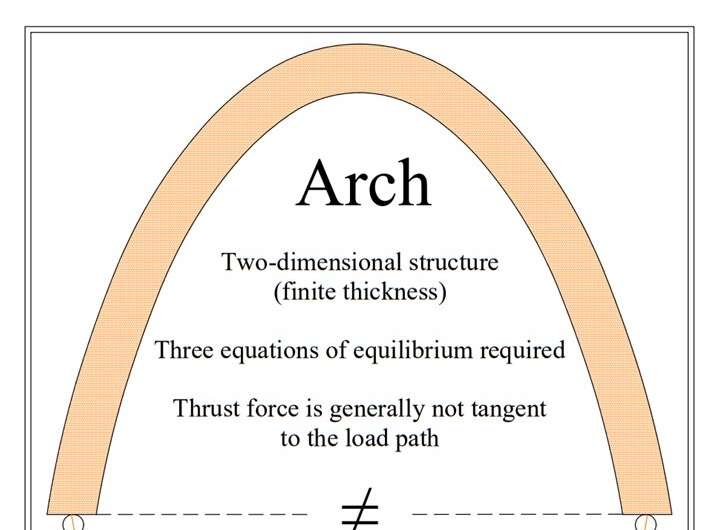This article has been reviewed according to Science X's editorial process and policies. Editors have highlighted the following attributes while ensuring the content's credibility:
fact-checked
trusted source
proofread
Researcher turns one of the basic rules of construction upside down

An Aston University researcher has turned one of the basic rules of construction on its head. For centuries a hanging chain has been used as an example to explain how masonry arches stand.
Structural engineers are familiar with seventeenth-century scientist Robert Hooke's theory that a hanging chain will mirror the shape of an upstanding rigid arch.
However, research from Aston University's College of Engineering and Physical Sciences, shows that this common-held belief is incorrect because, regardless of the similarities, the hanging chain and the arch are two incompatible mechanical systems.
Dr. Haris Alexakis used the transition in science from Newtonian to Lagrangian mechanics, that led to the development of modern physics and mathematics, to prove this with mathematical rigor.
In his paper, "Vector analysis and the stationary potential energy for assessing equilibrium of curved masonry structures," published in Mathematics and Mechanics of Solids he revisits the equilibrium of the hanging chain and the arch, explaining that the two systems operate in different spatial frameworks.
One consequence of this is that the hanging chain requires only translational force to be in equilibrium whereas the inverted arch needs both translational and rotational. As a result, the solutions are always different.
Dr. Alexakis's analysis unearthed subtle inconsistencies in the way Hooke's analogy has been interpreted and applied over the centuries for the design and safety assessment of arches, and highlights its practical limitations.
He said, "The analogy between inverted hanging chains and the optimal shape of masonry arches is a concept deeply rooted in our structural analysis practices. Curved structures have enabled masons, engineers, and architects to carry heavy loads and cover large spans with the use of low-tensile strength materials for centuries, while creating the marvels of the world's architectural heritage."
"Despite the long history of these practices, finding optimal structural forms and assessing the stability and safety of curved structures remains as topical as ever. This is due to an increasing interest to preserve heritage structures and reduce material use in construction, while replacing steel and concrete with low-carbon natural materials."
His paper suggests a new structural analysis method based on the principle of stationary potential energy which would be faster, more flexible and help calculate more complex geometries.
As a result, analysts won't need to consider equilibrium of each individual block or describe geometrically the load path of thrust forces to obtain a rigorous solution.
Dr. Alexakis added, "The analysis tools discussed in the paper will enable us to assess the condition and safety of heritage structures and build more sustainable curved structures, like vaults and shells. The major advantage of these structures, apart from having appealing aesthetics, is that they can have reduced volume, and can be made of economic, low-tensile-strength and low-carbon natural materials, contributing to net zero construction."
More information: Haris Alexakis et al, Vector analysis and the stationary potential energy for assessing equilibrium of curved masonry structures, Mathematics and Mechanics of Solids (2023). DOI: 10.1177/10812865231183355




















